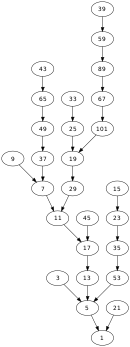- For even numbers, divide by 2;
- For odd numbers, multiply by 3 and add 1.

The Collatz conjecture[a] is one of the most famous unsolved problems in mathematics. The conjecture asks whether repeating two simple arithmetic operations will eventually transform every positive integer into 1. It concerns sequences of integers in which each term is obtained from the previous term as follows: if a term is even, the next term is one half of it. If a term is odd, the next term is 3 times the previous term plus 1. The conjecture is that these sequences always reach 1, no matter which positive integer is chosen to start the sequence. The conjecture has been shown to hold for all positive integers up to 2.95×1020, but no general proof has been found.
It is named after the mathematician Lothar Collatz, who introduced the idea in 1937, two years after receiving his doctorate.[4] The sequence of numbers involved is sometimes referred to as the hailstone sequence, hailstone numbers or hailstone numerals (because the values are usually subject to multiple descents and ascents like hailstones in a cloud),[5] or as wondrous numbers.[6]
Paul Erdős said about the Collatz conjecture: "Mathematics may not be ready for such problems."[7] Jeffrey Lagarias stated in 2010 that the Collatz conjecture "is an extraordinarily difficult problem, completely out of reach of present day mathematics".[8] However, though the Collatz conjecture itself remains open, efforts to solve the problem have led to new techniques and many partial results.[8][9]
- ^ Maddux, Cleborne D.; Johnson, D. Lamont (1997). Logo: A Retrospective. New York: Haworth Press. p. 160. ISBN 0-7890-0374-0.
The problem is also known by several other names, including: Ulam's conjecture, the Hailstone problem, the Syracuse problem, Kakutani's problem, Hasse's algorithm, and the Collatz problem.
- ^ Cite error: The named reference
Lagarias (1985)was invoked but never defined (see the help page). - ^ According to Lagarias (1985),[2] p. 4, the name "Syracuse problem" was proposed by Hasse in the 1950s, during a visit to Syracuse University.
- ^ O'Connor, John J.; Robertson, Edmund F., "Lothar Collatz", MacTutor History of Mathematics Archive, University of St Andrews
- ^ Pickover, Clifford A. (2001). Wonders of Numbers. Oxford: Oxford University Press. pp. 116–118. ISBN 0-19-513342-0.
- ^ Hofstadter, Douglas R. (1979). Gödel, Escher, Bach. New York: Basic Books. pp. 400–2. ISBN 0-465-02685-0.
- ^ Cite error: The named reference
Guy (2004)was invoked but never defined (see the help page). - ^ a b Cite error: The named reference
Lagarias (2010)was invoked but never defined (see the help page). - ^ Tao, Terence (2022). "Almost all orbits of the Collatz map attain almost bounded values". Forum of Mathematics, Pi. 10: e12. arXiv:1909.03562. doi:10.1017/fmp.2022.8. ISSN 2050-5086.
Cite error: There are <ref group=lower-alpha> tags or {{efn}} templates on this page, but the references will not show without a {{reflist|group=lower-alpha}} template or {{notelist}} template (see the help page).